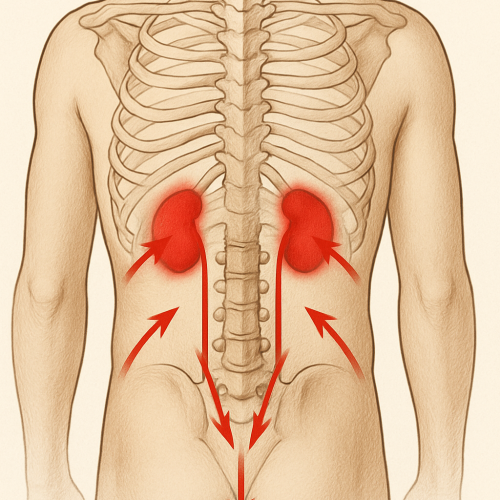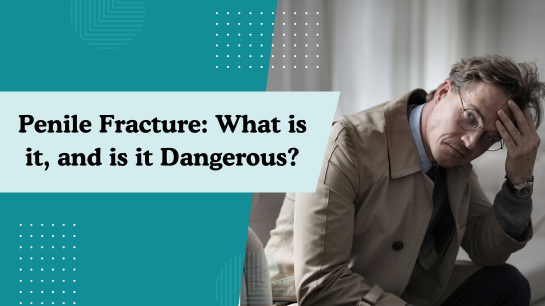Kidney Pain vs. Back Pain: How to Tell the Difference
When you feel an ache or discomfort in your back, it’s natural to wonder if it’s simply muscle strain or something more serious. Many people confuse kidney pain with ordinary back pain because both can occur in a similar area. However, the causes, sensations, and accompanying symptoms are often very different. Knowing how to tell the difference between back pain vs kidney pain can help you get the right treatment sooner and avoid unnecessary complications.
As a urologist in Dubai with more than 20 years of experience, I’ve seen many patients who arrive thinking they have back pain, but are actually suffering from a kidney problem. Understanding the signs is the first step toward protecting your health.
In this guide, we’ll explore where kidney pain is felt, how it differs from a regular backache, and what symptoms you should never ignore.
Understanding the Kidney Pain Area
Kidney stones are solid mineral and salt deposits that form in the kidneys due to dehyd
Your kidneys are bean-shaped organs located just below the rib cage, one on each side of your spine. The kidney pain area is typically around the upper back or flanks, rather than the lower back. This is a key difference because regular back pain often occurs in the lumbar region, which is further down.
Kidney pain often radiates to the sides, abdomen, or groin. It may be accompanied by urinary symptoms, fever, or nausea—clues that point toward a kidney issue rather than a strained muscle.
ration, diet, or underlying health conditions. Their size varies, ranging from tiny grains to large stones that block the urinary tract. The size of kidney stones significantly determines whether they can pass naturally or require medical intervention.
Where is Kidney Pain Felt?
If you’ve ever wondered where kidney pain is felt, picture an ache or sharp pain in kidney area located on either side of your spine, just below your ribs. Sometimes the pain is one-sided:
- Pain in kidney area right side
- Pain in kidney area left side
In certain cases, it can spread toward the front of your abdomen or down to the groin area. This pain in the kidney area does not usually improve with stretching or changing your position. That’s because it’s not related to the muscles or joints in your back—it’s coming from an internal organ.
How Does Kidney Pain Feel?
The nature of kidney pain can vary depending on its cause:
- Sharp pain in kidney area that may come in waves is often linked to kidney stones.
- Dull pain in kidney area is more common with infections or inflammation.
- Tenderness when pressing on the kidney area of the back.
If you’ve ever asked, “How does kidney pain feel?” think of it as deeper and more penetrating than muscle soreness. It’s usually felt inside the body rather than on the surface.
Does Kidney Pain Come and Go?
This is one of the most common questions people have about kidney discomfort.
- With kidney stones: the sharp pain in kidney area can come and go.
- With infections: the kidney area pain is usually steady and ongoing.
Is Kidney Pain Constant?
Many people describe kidney back pain area discomfort as continuous. Infections often cause a persistent ache, while stones cause intermittent but intense pain. However, both can be severe and may last for hours.
Common Kidney Pain Symptoms
In addition to pain in kidney area, you may experience:
- Fever or chills
- Nausea and vomiting
- Changes in urine color (pink, red, or brown)
- Cloudy or foul-smelling urine
- Pain or burning during urination
- Increased urgency or frequency of urination
These are strong indicators of a kidney infection pain area or another issue needing medical attention.
Also Read- What Size of Kidney Stone Requires Surgery?
Back Pain vs Kidney Pain: Key Differences
- Location
- Kidney area pain: Higher up under the ribs, often radiates to sides or groin
- Back pain: Lower back, may radiate to buttocks or legs
- Sensation
- Kidney pain: Deep, internal, not affected by movement
- Back pain: Can be dull or sharp, usually changes with posture
- Triggers
- Kidney pain: Not related to activity
- Back pain: Often follows strain, lifting, or poor posture
- Accompanying Symptoms
- Kidney pain: Urinary symptoms, fever, nausea
- Back pain: Stiffness, limited motion, muscle spasms

Other Surgical Procedures: When more direct action is needed?
Causes of Kidney Area Pain
- Kidney stones
- Kidney infections
- Polycystic kidney disease
- Kidney injury
- Slight pain in transplanted kidney area (post-transplant patients)
Causes of Back Pain in Kidney Area
While it may seem like kidney area back pain, the actual cause can be:
- Muscle or ligament strain
- Herniated discs
- Spinal arthritis
- Osteoporosis
When to See a Urologist in Dubai
Seek medical help if:
- You have pain in right kidney area or pain in left kidney area that’s severe
- There is blood in your urine
- You experience fever, nausea, or vomiting
- Your pain in lower back kidney area does not improve
At my urology clinic in Dubai, I offer advanced diagnostics and treatment for all forms of kidney back pain area issues.
Prevention Tips
- Stay hydrated to avoid stones and infections
- Maintain proper posture
- Eat a low-sodium, balanced diet
- Avoid overexerting your back
- Seek early treatment for any urinary symptoms
Also Read- Beer for Kidney Stones: Myths Vs Facts
Final Thoughts from Dr. Muthana Alrawi
Distinguishing back pain vs kidney pain is crucial. Here’s a quick summary:
- Find out where kidney pain is felt
- Symptoms: urinary changes, fever, nausea, persistent or sharp pain in kidney area left side or right side
- Type of pain: deep, sharp, or dull, usually not related to movement
If you’re experiencing any of these signs, especially severe pain in kidney area, don’t wait. Book a consultation with an expert.
When to Consult with Dr. Muthana Alrawi in Dubai
If you’re experiencing pain in the back kidney area, symptoms related to the kidney infection back pain area, or any other urological issue, I’m here to help. With over 20 years of experience in urology and andrology, I provide accurate diagnoses and tailored treatments.




